
Inbound Recruiting: The Essential Guide

What if the best candidates came to you, drawn by your brand, expertise, and genuine connection? This isn’t a futuristic fantasy; it’s the reality of inbound recruiting.
By embracing a content-driven, candidate-centric strategy, your agency can build lasting relationships and become the go-to resource for exceptional talent.
In this guide on inbound recruiting, we will cover the basics of inbound recruiting and the finer aspects with tips to get you started.
Let’s begin!
What is Inbound Recruiting?
Inbound recruiting is a strategy that focuses on creating and sharing valuable content to attract potential candidates to your organization, rather than actively searching for them.
It’s essentially about turning your company into a talent magnet by giving candidates compelling reasons to consider you as a great place to work.
Think of it as the recruitment equivalent of inbound marketing – instead of chasing candidates, you’re drawing them to you through relevant, helpful content and positive brand experiences.
Some of the core parts of inbound recruiting include:
- Employer branding: Crafting a compelling “why work here” narrative.
- Content marketing: Blogs, videos, and social posts that highlight company culture (e.g., “Day in the Life” videos).
- Social media engagement: Using platforms like LinkedIn, Instagram, or TikTok to humanize your client’s brand.
- Talent communities: Building pools of engaged candidates through newsletters or Slack groups.
Let’s look at how inbound recruiting works in practice. Take Aclipse, a small US-based recruiting agency connecting recruiters with recent graduates seeking teaching jobs in Asia.

Before implementing inbound recruiting, they spent significant resources on job board ads and direct mail campaigns, and ended up with many low-quality leads.
After shifting to an inbound approach using HubSpot, social media engagement, and content marketing, Aclipse dramatically improved both the quantity and quality of candidates.
They created targeted content offers, optimized landing pages, and implemented lead-nurturing campaigns to engage potential candidates throughout their journey.
The result? They were able to:
- Save $1500 to $2000 per month by eliminating online ads
- Increase fan engagement on social media networks by 50%
- Improve conversion rates on landing pages by 33% (5 times higher than average)
- Boost their organic traffic by 100%
Inbound vs Outbound Recruitment
Recruiting talent is a lot like fishing—you can either cast a wide net and wait for the fish to come to you (inbound), or you can actively chase the fish in the open water (outbound).
Both approaches have their merits, but understanding the differences is key to deciding which strategy works best for your agency.
Inbound recruitment focuses on attracting candidates to your organization by building a strong employer brand and creating engaging, value-driven content.
Key characteristics of inbound recruitment:
- Content-Driven: Blogs, social media posts, videos, and career pages are used to showcase the company culture, values, and opportunities.
- Long-Term Strategy: It takes time to build a pipeline of candidates who are genuinely interested in your company.
- Candidate Experience Focused: The goal is to make candidates feel valued from the first interaction.
Also, read – How to Use Outbound Recruiting to Hire Faster
HubSpot’s inbound recruiting strategy is often cited as a gold standard. Hubspot shares authentic employee stories and offers free resources like eBooks on professional development to attract candidates who align with their mission and values.

Outbound recruitment is more proactive. It involves directly reaching out to potential candidates through methods like cold emails, LinkedIn messages, or headhunting. It’s all about finding talent rather than waiting for them to come to you.
For example, a tech startup needing a specialized AI engineer might use outbound tactics like sourcing profiles on GitHub or Stack Overflow and sending personalized messages to prospects.
Some of the key characteristics of outbound recruitment include:
- Proactive Approach: Recruiters actively search for and contact candidates who meet specific criteria.
- Short-Term Results: It’s often used to fill immediate vacancies or hard-to-fill roles.
- Targeted Efforts: Ideal for niche roles where the talent pool is small.
Inbound vs Outbound: A Side-by-Side Comparison
| Aspect | Inbound Recruitment | Outbound Recruitment |
| Approach | Attracts candidates through branding | Actively seeks out candidates |
| Timeline | Long-term pipeline building | Short-term, immediate hiring |
| Candidate Pool | Larger but less targeted | Smaller but highly targeted |
| Cost | Higher upfront investment in content creation | Higher cost per hire due to outreach efforts |
| Best For | Building employer brand and future talent | Filling urgent or niche roles |
When Should You Use Each Approach?
Inbound recruitment works best when:
- You’re focused on long-term hiring goals.
- Employer branding is a priority.
- You want to attract passive candidates who align with your company culture.
Outbound recruitment works best when:
- You need to fill roles quickly.
- The position requires highly specialized skills.
- Your inbound pipeline isn’t yielding enough qualified candidates.
Combining Inbound and Outbound for Maximum Impact
Why choose one when you can have both? A hybrid approach can give you the best of both worlds. For instance:
- Use inbound strategies to build a strong employer brand that attracts passive candidates over time.
- Simultaneously, leverage outbound tactics for immediate hiring needs or hard-to-fill positions.
Tools like LinkedIn Recruiter can help bridge the gap between inbound and outbound by allowing recruiters to both source candidates (outbound) and showcase their company culture through LinkedIn posts (inbound).

Read More: Sourcing vs Recruiting: What Are the Differences?
Benefits of Inbound Recruitment
Inbound recruitment is the go-to recruitment approach for forward-thinking recruiters who want to work smarter, not harder. Let’s dive into the major benefits that make inbound recruiting worth your time and investment.
Higher Quality Candidates Who Actually Fit
Isn’t it frustrating when you spend hours screening candidates only to realize they’re just not the right cultural fit? Inbound recruiting solves this problem at its root.
When candidates discover your company through your employer branding efforts and decide to apply, they’ve already self-selected based on what they know about your organization’s values and culture.
They’re not just looking for any job—they’re looking for your job. Clear, intentional branding attracts people who are a better fit for your company.
These folks saw your career page, resonated with it, and voluntarily decided to apply. This results in a more cohesive company culture with shared values and higher employee engagement.
According to LinkedIn’s Employer Brand Statistics, 72% of recruiters believe employer branding significantly impacts hiring success. That’s not just a coincidence—it’s a direct result of attracting candidates who already feel connected to your organization’s mission.
Time and Cost Efficiency That Boosts Your Bottom Line
Traditional recruiting takes time, money, and a whole lot of energy. The beauty of inbound recruiting? Once you’ve set up your strategy, candidates start flowing in without you having to chase after each one individually.
Here’s how inbound recruiting saves you resources:
- Reduced time-to-hire: Quick turnaround times are one of the best benefits of inbound recruitment for hiring teams and applicants alike. It becomes much easier to fill vacancies when the volume and quality of your candidates increase.
- Lower cost-per-hire: When candidates come to you, you spend less on sourcing activities like paid job boards or headhunters.
- Decreased recruiter workload: Your team can focus on evaluating and engaging with pre-qualified candidates rather than hunting them down.
With 75% of US employers reporting difficulty hiring talent and vacancy rates reaching 10.7 million openings, having a system that brings qualified candidates to your doorstep isn’t just convenient—it’s a competitive advantage.
Enhanced Employer Brand Recognition
Your employer brand isn’t just what you say about your company—it’s what talent in the market believes about working for you. Inbound recruiting both builds and leverages this reputation.
When you create valuable content about your workplace culture, professional development opportunities, and employee successes, you’re not just attracting immediate applicants—you’re building long-term brand equity in the talent marketplace.
Job posts with transparent salary information achieve 75% more clicks compared to those that don’t disclose compensation. Transparency is just one aspect of a strong employer brand that attracts more eyeballs to your opportunities.
Improved Candidate Experience From First Touch
Ever applied for a job only to enter the infamous “application black hole”? Around 78% of candidates report feeling more frustrated by not hearing back after sending an application than “being ghosted after a first date”.
Inbound recruiting naturally improves the candidate experience because it’s built on engagement rather than transaction. When candidates discover your content, learn about your values, and connect with your brand before applying, they already feel valued.
Here’s how inbound recruiting enhances candidate experience:
- Creates multiple touchpoints before the formal application process
- Provides valuable information that candidates actually want
- Establishes realistic expectations about your company culture and work environment
- Builds relationship equity that carries through the hiring process
Better Talent Pipeline Development
One of the most overlooked benefits of inbound recruiting is its ability to build relationships with passive candidates who aren’t ready to apply today but might be perfect fits tomorrow.
By creating valuable content that attracts industry professionals to your brand, you’re filling your talent pipeline with pre-qualified individuals who already know and like your organization.
When they’re ready to make a move, guess who they’ll think of first?
With 70% of firms performing their recruitment processes in a hybrid virtual format, the digital touchpoints of inbound recruiting align perfectly with how modern candidates prefer to engage.
Potential Drawbacks and Challenges
While inbound recruiting can really make a difference (who doesn’t want candidates coming to YOU?), it’s not all sunshine and rainbows.
Many agencies jump on the inbound bandwagon only to get frustrated when things don’t magically work overnight.
So before you go all-in, let’s talk about some speed bumps you might encounter along the way.
The Waiting Game
If you’ve planted a garden, you know that you don’t get tomatoes the day after you put seeds in the ground, right? Inbound recruiting works the same way.
Companies must plan, implement, and regularly evaluate progress to build a strong employer brand. Like other online marketing campaigns, it requires patience and trial and error before your inbound recruiting process can operate on its own.
How long are we talking? According to recruitment experts:
- Most companies see meaningful results after 4-6 months of consistent effort
- Content needs time to gain traction in search engines
- Employer branding is a long-term investment, not a quick fix
To manage the time challenge:
- Set realistic expectations with stakeholders from the beginning
- Create a content calendar to ensure consistent publishing
- Repurpose existing content while building new materials
- Consider a hybrid approach using both inbound and outbound strategies while your inbound pipeline develops
Drowning in Applications
Once your inbound strategy gains momentum, high volumes of applications can come out of nowhere. It’s crucial to be prepared for this number of applicants and stay focused once they arrive.
Remember that inbound recruitment is all about getting the best talent, not just any talent.
Here’s how to handle application overload:
- Implement an ATS (Applicant Tracking System) with strong filtering capabilities
- Use knockout questions to automatically screen candidates
- Create templated responses to maintain communication without burning out
- Consider AI-powered screening tools to identify top candidates
- Develop a clear scoring system for evaluating applications quickly
Also read our blog on the best social media recruiting tools.
Square Peg, Round Hole
Inbound isn’t the perfect solution for every hiring need you’ll ever have. Inbound recruitment can be less effective for some roles, including short-term positions and non-core business roles.
An example is an accounting role at a restaurant – positions like this might need more outbound recruitment techniques.
When inbound might fall short:
- Highly specialized roles requiring rare technical skills
- Executive positions where discretion is paramount
- Urgent hiring needs with immediate start dates
- Positions in locations with limited talent pools
- Roles in companies without strong brand recognition
Some alternative approaches:
- Create a hybrid strategy with role-specific tactics
- Partner with specialized staffing agencies for harder-to-fill positions
- Leverage employee referrals for specialized roles (still technically inbound!)
- Use direct sourcing for urgent or highly specialized needs
Content Fatigue
Creating quality content consistently is challenging but essential for inbound recruiting.
Without fresh, engaging content, your talent pipeline will eventually dry up.
The content challenge breakdown:
- Content creation requires significant resources and creativity
- Content needs regular updating to remain relevant
- Poor content can actually damage your employer brand
How do you overcome content fatigue? Here’s how:
- Create a content calendar with diverse formats (videos, blog posts, podcasts, etc.)
- Involve employees from different departments in content creation
- Repurpose successful content into different formats
- Focus on evergreen content that remains relevant longer
- Consider outsourcing some content creation to specialists
Pro tip: Conduct regular candidate surveys to understand what content resonates most with your target audience. This prevents wasted effort on content types that don’t convert.
Measurement Madness
“What’s the ROI of our inbound recruiting efforts?” – your boss, eventually.
Unlike traditional recruitment, where you can track cost-per-hire fairly directly, inbound recruiting benefits can be harder to quantify, especially in the early stages.
The measurement challenge looks something like this:
- Attribution is difficult when candidates interact with multiple touchpoints
- Long-term benefits like improved retention aren’t immediately visible
- Standard recruitment metrics may not capture the full value
Here are some ways to create meaningful metrics:
- Track application source data meticulously
- Measure time-to-hire for inbound vs. outbound candidates
- Compare quality-of-hire metrics between recruiting channels
- Monitor cost-per-hire over time as your inbound strategy matures
- Survey new hires about which content influenced their decision to apply
Crowded Market
When everyone zigs, you need to zag. As more companies adopt inbound recruiting strategies, standing out becomes increasingly difficult.
Breaking through the noise requires you to:
- Develop a unique employer value proposition that truly differentiates you
- Focus on authentic employee stories rather than generic corporate content
- Create interactive experiences rather than passive content consumption
- Target niche communities where your ideal candidates gather
- Leverage video content, which often has higher engagement rates
How to Implement an Inbound Recruiting Strategy
Let’s break down how you can implement an effective inbound recruiting strategy that actually works in today’s competitive talent market.
Align Your Strategy with Organizational Goals
First things first – what’s the point of an amazing inbound strategy if it doesn’t help achieve your company’s broader objectives?
Are you planning to expand into new territories? Or maybe you’re looking to diversify your workforce? Your inbound recruiting efforts should directly support these goals.
For example, if you’re opening a new office in Austin, your content and targeting should speak directly to candidates in that area.
If you’re trying to hire more technical talent with specific skills, your messaging should highlight the technical challenges and opportunities at your company.
Some practical ways to align your strategy:
- Create location-specific landing pages for expansion areas
- Develop content that showcases the values you’re looking to bring into your organization
- Target your PPC campaigns to reflect organizational priorities
- Adjust messaging to attract the types of candidates that support your business goals
Remember, alignment isn’t a one-time thing. As your organization’s goals shift, your inbound recruiting strategy should evolve accordingly.
Develop Detailed Candidate Personas
You need to know exactly who you’re trying to attract.
Creating detailed candidate personas helps you understand:
- Where your ideal candidates spend their time online
- What content formats do they prefer to consume
- Which messages will resonate with them
- What they value in an employer

Start building personas by asking three key questions:
- What knowledge, skills, and qualifications are we looking for?
- What tasks will they perform daily?
- What demographic data or personal attributes will be the focus?
Pro tip: Don’t just create these personas based on assumptions. Talk to your top performers, survey recent hires, and analyze the backgrounds of your most successful employees. The more data-driven your personas, the more effective they’ll be.
Build a Compelling Employer Brand
In today’s transparent world, candidates research companies extensively before even considering applying.
Here’s what an effective employer branding strategy includes:
- Authentic employee stories and testimonials
- Consistent messaging across all platforms
- Clear communication of company values and culture
- Regular updates about company milestones and achievements
Companies like Starbucks and UPS have mastered this with robust social media presences that showcase not just what they do, but who they are as employers.

They understand that in inbound recruiting, you’re approaching candidates as potential customers, speaking to a wide audience with the aim of conversion.
Want to boost your employer brand credibility? Consider applying for employer recognition awards. According to Top Workplaces, these awards show potential applicants how your current employees perceive your company and culture.
Create and Promote Strategic Content
Content is the fuel that powers your inbound recruiting engine. But not just any content – it needs to be strategic, targeted, and valuable to your ideal candidates.
Did you know that 70% of job searches begin on Google? This means SEO optimization of your career pages isn’t optional – it’s essential.
Try these content strategies:
1. Create a dedicated blog section for employee experiences and culture (Google does this exceptionally well with its “Inside Google” blog section).
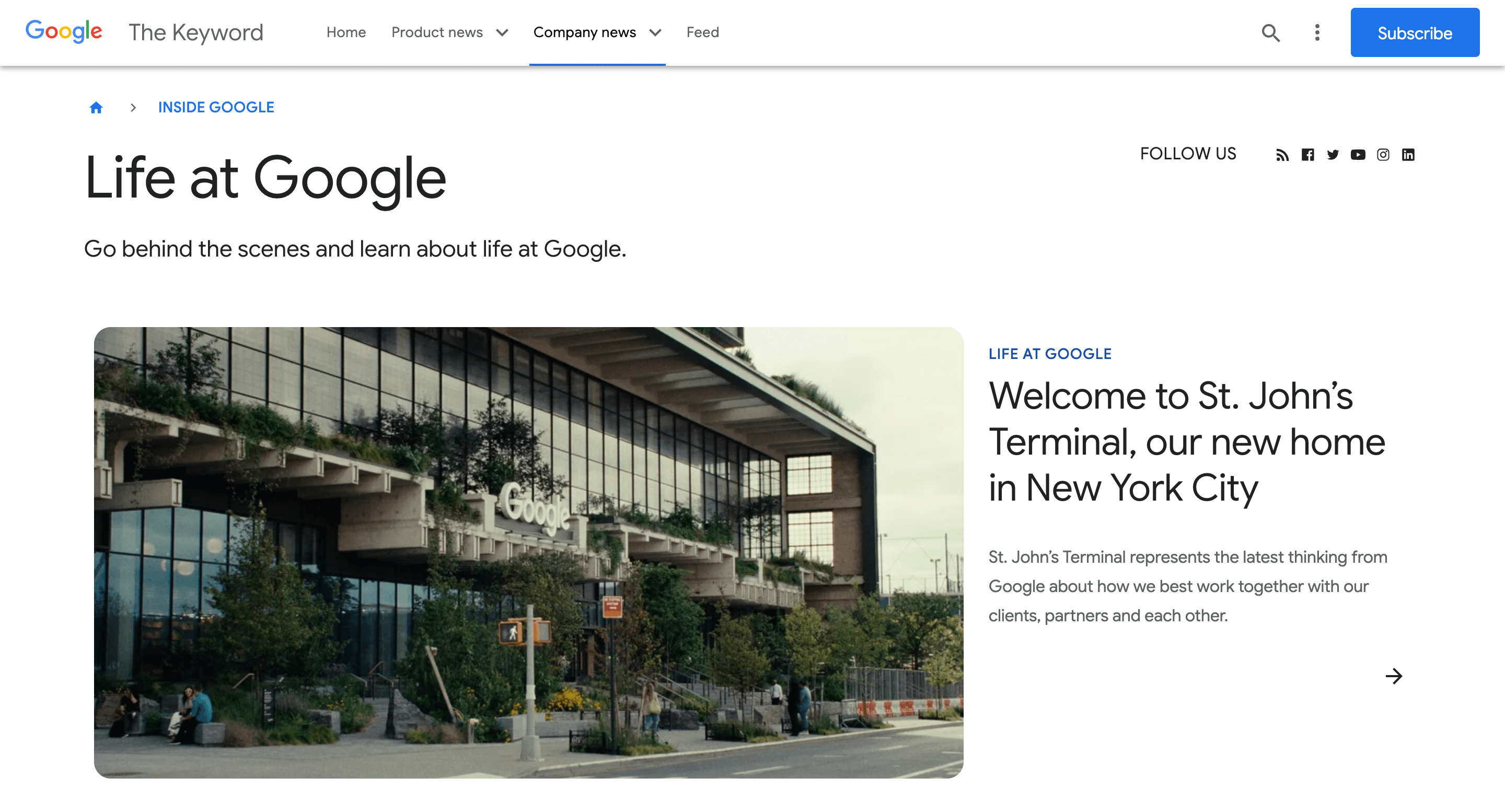
2. Develop engaging landing pages that showcase your culture (check out Spotify’s careers page for inspiration).

3. Design infographics about your benefits and perks.

4. Produce videos showing “a day in the life” at your company.

5. Write thought leadership articles demonstrating your industry expertise.

For content ideas, think about what your candidates are searching for. Are they looking for career development opportunities? Work-life balance? Technical challenges? Create content that answers these questions.
Leverage Multiple Channels Effectively
Are you only posting job ads on LinkedIn? You’re missing out on huge potential candidate pools! Different candidates hang out in different online spaces, so your inbound strategy needs to be multi-channel.
Take HubSpot as an example – they have a separate Instagram account called “HubSpot Life” dedicated entirely to showcasing their work culture and employee stories.

But they don’t stop there – they maintain active presences across LinkedIn, Twitter, and various other platforms.
Each platform requires a different approach:
- Instagram: Short, visual content showing company culture
- LinkedIn: Professional insights and thought leadership
- Twitter: Quick updates and engagement
- YouTube: Longer-form videos about company values and employee experiences
- Industry forums: Specialized discussions showcasing expertise
The key is consistency in your employer brand messaging while tailoring the format to each platform’s strengths. And don’t forget to track which channels perform best for different roles – this data is gold for refining your strategy.
Build and Nurture a Talent Community
Had a great candidate who just wasn’t quite ready to make a move? That’s where talent communities come in. They allow you to maintain relationships with potential future hires, keeping them engaged with your brand until the timing is right.
For example, TripleDart, a SaaS marketing agency, regularly adds writers to its community. Whenever they need a writer with expertise in a particular niche, they have a pre-built pool to tap into.

To build an effective talent community:
- Create a simple sign-up process for interested candidates
- Send regular, valuable updates (not just job postings)
- Segment your community by skills, interests, and experience
- Offer exclusive insights and content to community members
- Host virtual events for community engagement
Think of your talent community not as a database, but as a relationship-building tool. The more value you provide, the stronger these relationships become.
Sponsor Strategic Events
Events provide fantastic opportunities to showcase your company culture and connect with potential candidates in person or virtually.
Amazon, for instance, sponsors tech conferences like AWS Global Summits and Grace Hopper Celebration to connect with professionals in cloud computing, software development, and AI.

Don’t have Amazon’s budget? No problem! You can:
- Host smaller, focused meetups in your office
- Sponsor local industry gatherings
- Organize virtual webinars or workshops
- Participate in career fairs at targeted universities
- Create online hackathons or competitions
The key is selecting events that attract your ideal candidates and showcasing what makes your company special. And always, always follow up with the connections you make – a quick LinkedIn message or email can transform a casual conversation into a recruiting opportunity.
Implement the Three-Step Inbound Process
HubSpot popularized the inbound concept back in 2006 (albeit in marketing), and today’s most effective inbound recruiting strategies follow a similar three-step approach:
1. Build Awareness
This stage targets top-of-funnel candidates who might not know much about your organization yet. Focus on:
- SEO-optimized career pages and web content
- Blogs about company culture and values
- Social media posts showcasing employee events
- A well-structured employee referral program
2. Convert Prospects
Now you’re dealing with mid-funnel candidates who are aware of your company and might be interested. Apply conversion analytics to identify the most promising prospects, and use targeted employer branding ads to move them further down the funnel.
3. Engage and Handover to Outbound
At this stage, interested candidates are ready to learn about specific opportunities. Implement a robust candidate relationship management (CRM) system to ensure a seamless experience, then connect them with your outbound recruiters to match them with actual vacancies and begin the formal application process.
Read More: Recruiting Funnel: A Complete Guide
Measure and Optimize Results
You need to start by tracking the right metrics. Essential metrics to monitor include:
- Traffic to your careers pages (via Google Analytics)
- Application completion rates
- Source effectiveness (which channels bring the most qualified candidates)
- Keyword performance (via Google Search Console)
- Time-to-hire for inbound vs. outbound candidates
- Cost-per-hire comparisons between methods
Pro tip: Don’t just collect data – actually use it! Schedule monthly reviews to analyze your metrics and make strategic adjustments to your approach. The most successful inbound recruiting strategies are those that continuously evolve based on results.
Be Patient and Persistent
Inbound recruiting is a long-term investment. Unlike outbound recruiting, which can produce immediate results, inbound strategies take time to build momentum.
According to experts, inbound recruiting campaigns are long-term investments, with ROI taking time to materialize.
But once they do, the results can be transformative – a steady stream of qualified, engaged candidates who are already familiar with your brand and excited about your opportunities.
The key is persistence. Keep creating content, engaging with your audience, and refining your approach. Over time, you’ll build a recruiting engine that continuously attracts top talent to your door.
Best Inbound Recruiting Software for 2025
The right inbound recruiting tool can transform your passive candidate attraction strategy from a trickle to a steady stream of quality applicants.
The most effective inbound recruiting platforms combine automation, personalization, and analytics to create a magnetic presence that draws candidates to your opportunities without constant outreach efforts.
Key Features to Look for in Inbound Recruiting Software
Before diving into specific recommendations, let’s talk about what actually matters when selecting inbound recruiting software.
Here are some must-have capabilities:
- Career Site Builder: Customizable, mobile-friendly landing pages that showcase your employer brand
- Content Management System: Tools to create and distribute engaging recruitment content
- Social Media Integration: Seamless posting and promotion across platforms
- Candidate Relationship Management: Nurture passive talent with automated sequences
- Analytics Dashboard: Measure which channels and content drive the best candidates
- SEO Optimization: Help your jobs rank higher in search results
Top Inbound Recruiting Software Options for 2025
1. Recruiterflow
Recruiterflow is an AI-first recruitment operations platform used by some of the most ambitious agencies on this planet.
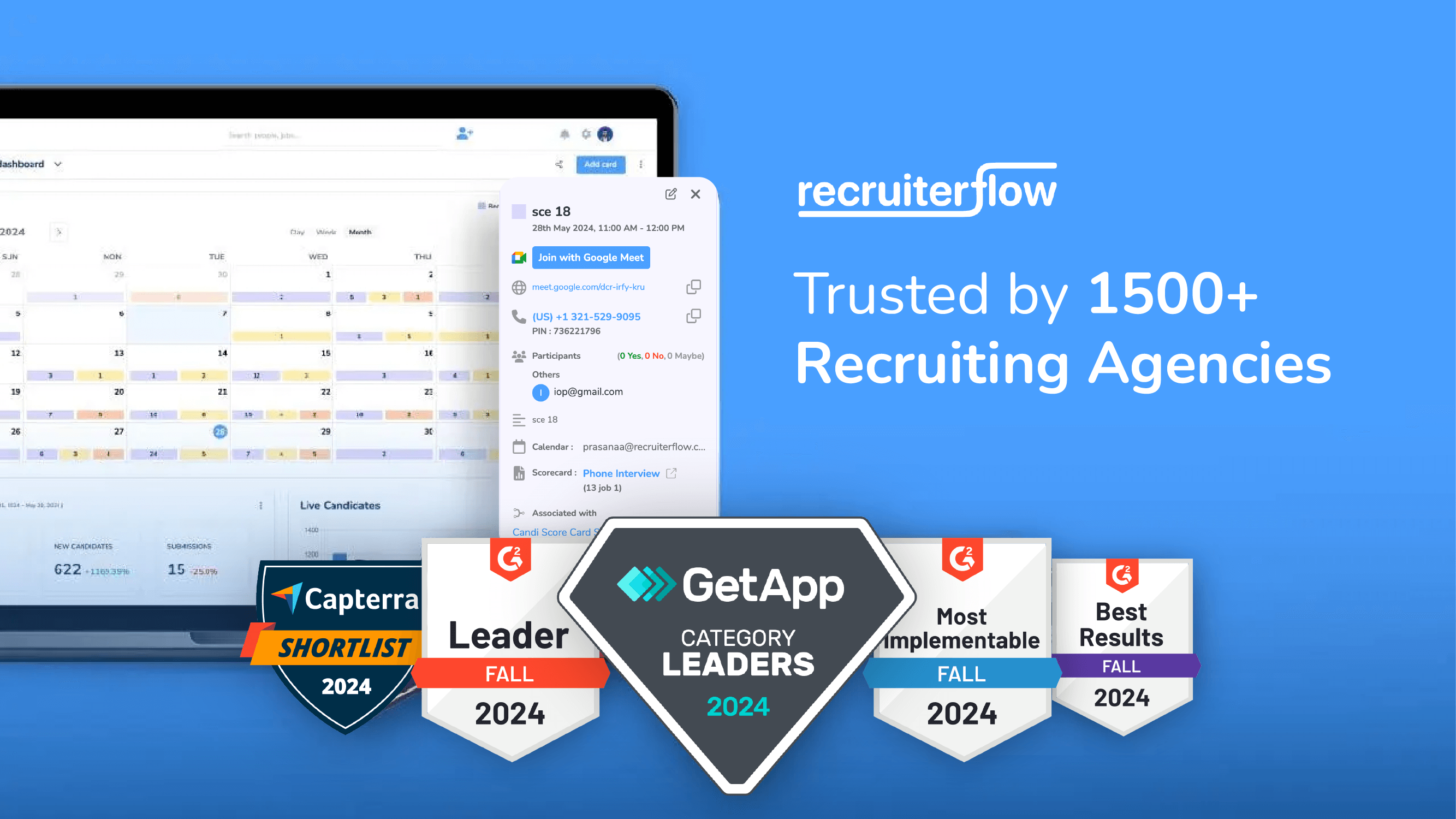
It supports inbound recruiting by providing tools that help attract, engage, and nurture candidates effectively. Here’s how it facilitates inbound recruiting:
Streamlined Candidate Attraction
Recruiterflow lets you post jobs on multiple job boards for free. You thereby get a steady influx of candidates who are genuinely interested in the roles you offer.
Plus, you can quickly DIY branded career pages with its no-code career site builder. Also, its AI recruiting assistant helps you create SEO-optimized job content that ranks higher.
Automated Candidate Engagement
Recruiterflow’s multi-touchpoint sequencing feature allows personalized communication through automated, personalized email and text campaigns, keeping candidates engaged throughout the process.
Automated tasks like email follow-ups and interview scheduling free up time for recruiters to focus on building meaningful connections with potential hires.
Nurturing Passive Candidates
Recruiterflow’s CRM functionality helps recruiters maintain relationships with both active and passive candidates by tracking interactions and managing communications effectively.
Data-Driven Insights
Recruiterflow provides analytics tools to track key performance indicators (KPIs) such as time-to-fill metrics and sourcing effectiveness, so you can refine your inbound recruitment strategies over time.
Recruiterflow works particularly well for agencies that need to manage both inbound strategies and recruitment client relationships in one platform.
The 14-day free access lets you test core functionality before committing to a paid plan.
2. Workable
Workable stands out as a candidate-centered recruiting automation software that excels at inbound strategies for fast-growing SMBs. What makes it special? Workable combines powerful job board distribution with customizable career pages that actually convert visitors into applicants.
Key Features:
- AI-powered candidate matching that automatically surfaces relevant talent
- Customizable workflows that nurture passive candidates
- Robust analytics to track which inbound channels perform best
- SEO-optimized job postings that rank higher in search results
3. Gem
When it comes to building relationships with passive candidates (the heart of inbound recruiting), Gem truly shines. This platform excels at creating personalized, automated nurture campaigns that keep your agency top-of-mind.
Key Features:
- Customizable automated drip campaigns to attract and nurture candidates
- The innovative “Likely to Move” filter identifies candidates more receptive to new opportunities
- Auto-adds profiles into specific talent pools based on set criteria
- Real-time visualized reports with actionable hiring metrics
4. Paradox
Want to engage candidates 24/7 without burning out your team? Paradox offers human-like conversational AI that can qualify, engage, and nurture candidates automatically.
Key Features:
- An AI chatbot that feels remarkably human in conversations
- Automated screening and scheduling capabilities
- Personalized candidate journeys based on qualifications and interests
- Seamless integration with your existing ATS
5. Zoho Recruit
Not every agency has an unlimited tech budget, which is why Zoho Recruit deserves attention. It offers robust inbound recruiting features with a free-forever plan to get you started.
Key Features:
- Complete ATS functionality with career site builder
- Social recruiting tools to amplify your employer brand
- Candidate engagement automation sequences
- Custom forms and landing pages for different roles
6. Manatal
If you’re looking for a system that not only attracts candidates but intelligently helps you identify the best ones, Manatal should be on your radar. It’s particularly strong for SMB-focused recruiting with its AI recommendation engine.
Key Features:
- Automatic candidate profile updates from social media (perfect for passive talent pools)
- AI-powered recommendations based on job descriptions
- Customizable automated post-referral and post-application emails
- Multi-language support on careers pages
How to Choose the Right Inbound Recruiting Software
Here’s my straightforward approach to selecting the right tool for your specific needs:
- Audit your current recruitment process – Where are the bottlenecks? Which manual tasks consume most of your time?
- Identify your inbound goals – Are you focusing on volume, quality, diversity, or specialized talent?
- Consider your tech stack – Which tools do you already use that need integration?
- Set a realistic budget – Remember to factor in implementation and training costs
- Prioritize features – Separate “must-haves” from “nice-to-haves”
Implementation typically takes a few weeks for most recruiting platforms, so plan accordingly and ensure you have team buy-in before making the switch.
Learn How Recruiterflow Can Be Your Inbound Recruiting Tech Partner
Recruiterflow helps your agency scale its inbound recruiting efforts, reduce costs, and focus on building relationships with qualified candidates.

It provides your agency with all the tools you need to manage your operations and scale faster:
- Unified ATS & CRM
- Centralized recruitment database
- No-code recruiting automation
- Automated, multi-channel outreach (Email, SMS, Call, & Socials)
- AI-first screening and sourcing tools
- Data enrichment capabilities
- Advanced reporting and analytics
- Open APIs and a host of integrations
Scott S., a Recruitment Specialist, reviewed us on G2Crowd:
“I’ve been using Recruiterflow, and it’s been a game-changer for streamlining my recruitment process. The automation tools for campaigns to candidates, LinkedIn, email integration, and customizable pipelines make managing candidates and clients so much easier. I love how it cuts down on manual work, letting me focus on building relationships instead of chasing admin tasks.”
See it in action now: Book a free demo
Recruitment

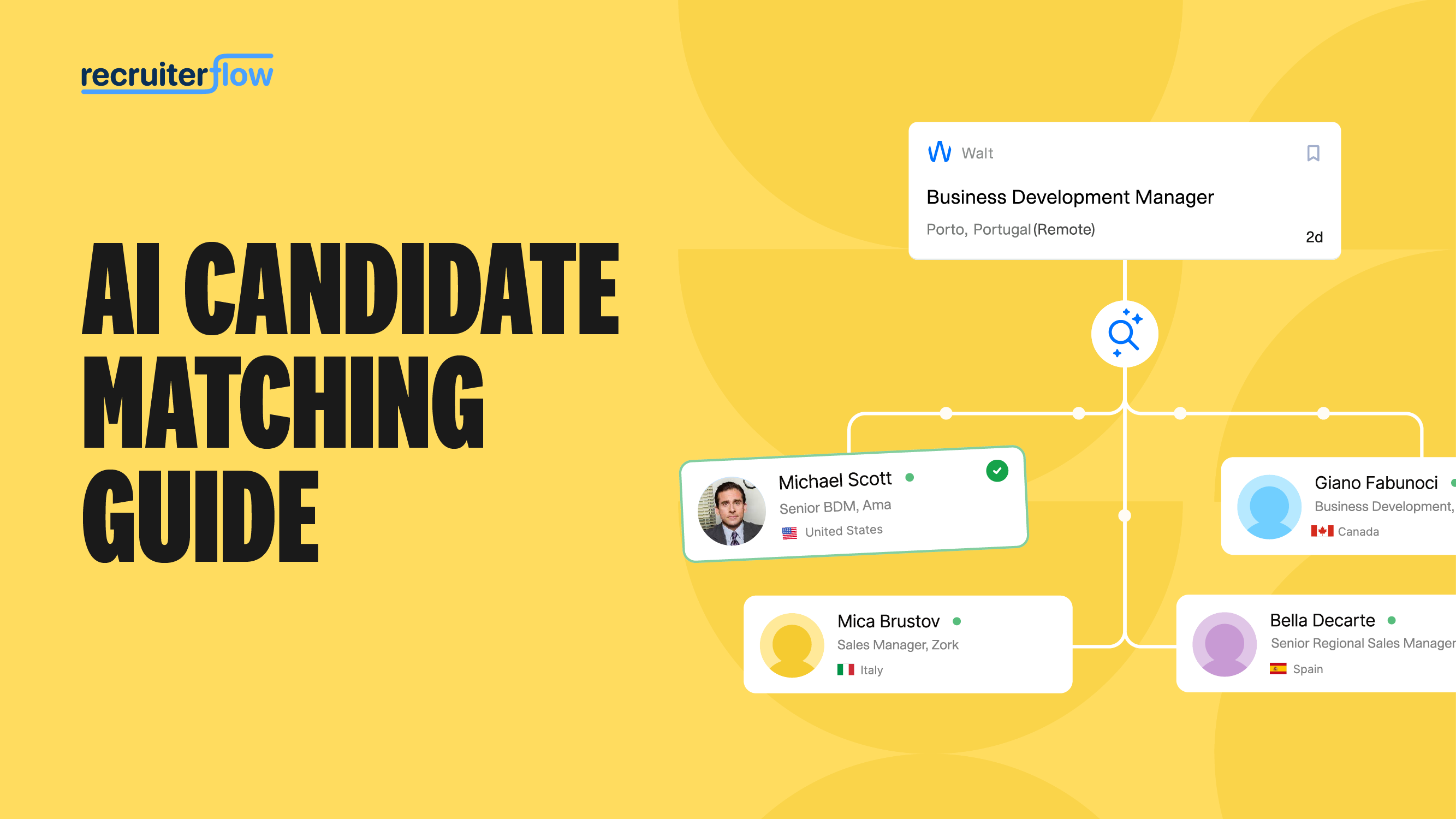

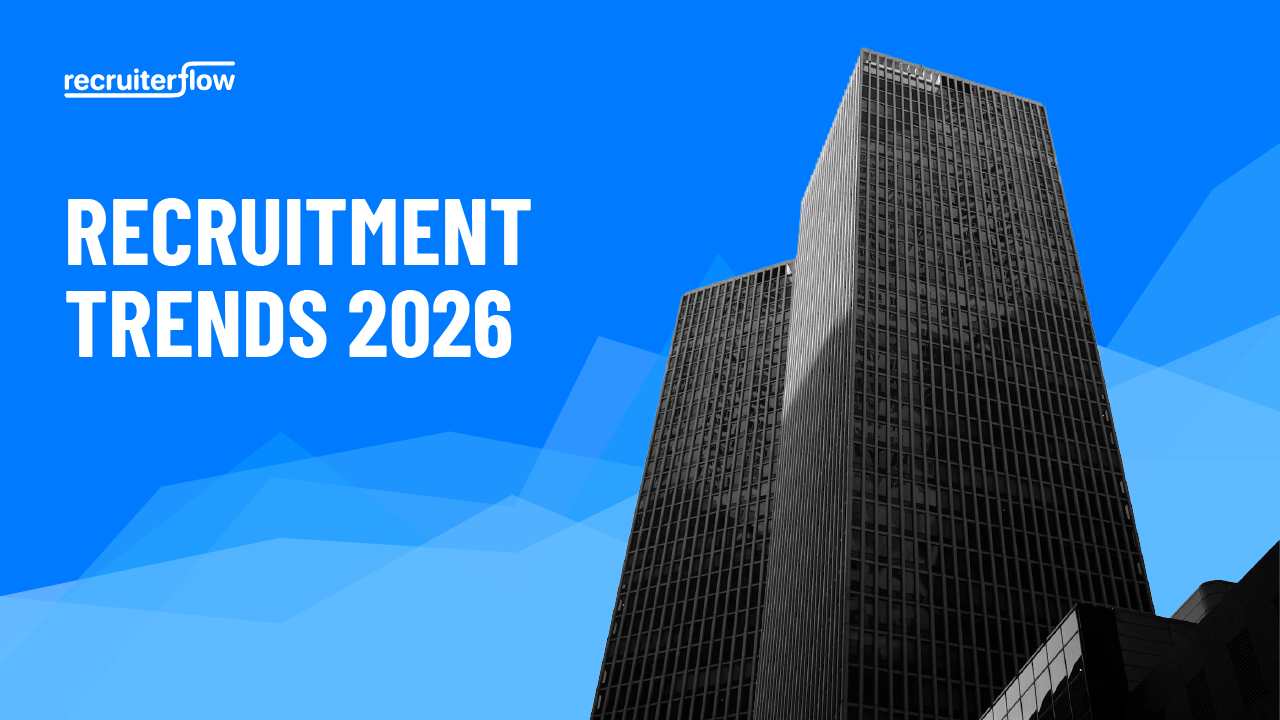
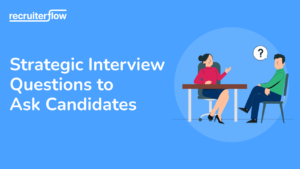

Pragadeesh Natarajan